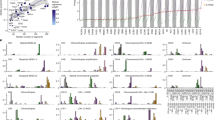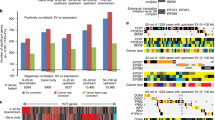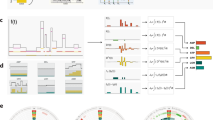Abstract
A powerful way to discover key genes with causal roles in oncogenesis is to identify genomic regions that undergo frequent alteration in human cancers. Here we present high-resolution analyses of somatic copy-number alterations (SCNAs) from 3,131 cancer specimens, belonging largely to 26 histological types. We identify 158 regions of focal SCNA that are altered at significant frequency across several cancer types, of which 122 cannot be explained by the presence of a known cancer _target gene located within these regions. Several gene families are enriched among these regions of focal SCNA, including the BCL2 family of apoptosis regulators and the NF-κΒ pathway. We show that cancer cells containing amplifications surrounding the MCL1 and BCL2L1 anti-apoptotic genes depend on the expression of these genes for survival. Finally, we demonstrate that a large majority of SCNAs identified in individual cancer types are present in several cancer types.
This is a preview of subscription content, access via your institution
Access options
Subscribe to this journal
Receive 51 print issues and online access
We are sorry, but there is no personal subscription option available for your country.
Buy this article
- Purchase on SpringerLink
- Instant access to full article PDF
Prices may be subject to local taxes which are calculated during checkout




Similar content being viewed by others
References
Futreal, P. A. et al. A census of human cancer genes. Nature Rev. Cancer 4, 177–183 (2004)
Stuart, D. & Sellers, W. R. Linking somatic genetic alterations in cancer to therapeutics. Curr. Opin. Cell Biol. 21, 304–310 (2009)
Stratton, M. R., Campbell, P. J. & Futreal, P. A. The cancer genome. Nature 458, 719–724 (2009)
Baudis, M. Genomic imbalances in 5918 malignant epithelial tumors: an explorative meta-analysis of chromosomal CGH data. BMC Cancer 7, 226 (2007)
Mitelman Database of Chromosome Aberrations in Cancer (eds Mitelman, F. Johansson, B. and Mertens, F.) 〈http://cgap.nci.nih.gov/Chromosomes/Mitelman〉 (2009)
NCI and NCBI’s SKY/M-FISH and CGH Database 〈http://www.ncbi.nlm.nih.gov/sky/skyweb.cgi〉 (2001)
Weir, B. A. et al. Characterizing the cancer genome in lung adenocarcinoma. Nature 450, 893–898 (2007)
Eder, A. M. et al. Atypical PKCiota contributes to poor prognosis through loss of apical-basal polarity and cyclin E overexpression in ovarian cancer. Proc. Natl Acad. Sci. USA 102, 12519–12524 (2005)
Lahortiga, I. et al. Duplication of the MYB oncogene in T cell acute lymphoblastic leukemia. Nature Genet. 39, 593–595 (2007)
Zender, L. et al. Identification and validation of oncogenes in liver cancer using an integrative oncogenomic approach. Cell 125, 1253–1267 (2006)
Mullighan, C. G. et al. Genome-wide analysis of genetic alterations in acute lymphoblastic leukaemia. Nature 446, 758–764 (2007)
Wiedemeyer, R. et al. Feedback circuit among INK4 tumor suppressors constrains human glioblastoma development. Cancer Cell 13, 355–364 (2008)
Cancer_Genome_Atlas_Research_Network. Comprehensive genomic characterization defines human glioblastoma genes and core pathways. Nature 455, 1061–1068 (2008)
Chitale, D. et al. An integrated genomic analysis of lung cancer reveals loss of DUSP4 in EGFR-mutant tumors. Oncogene 28, 2773–2783 (2009)
GlaxoSmithKline. GSK Cancer Cell Line Genomic Profiling Data 〈https://cabig.nci.nih.gov/tools/caArray_GSKdata〉 (2008)
Mullighan, C. G. et al. BCR-ABL1 lymphoblastic leukaemia is characterized by the deletion of Ikaros. Nature 453, 110–114 (2008)
Mazzarella, R. & Schlessinger, D. Pathological consequences of sequence duplications in the human genome. Genome Res. 8, 1007 (1998)
Beroukhim, R. et al. Assessing the significance of chromosomal aberrations in cancer: methodology and application to glioma. Proc. Natl Acad. Sci. USA 104, 20007–20012 (2007)
Garraway, L. A. et al. Integrative genomic analyses identify MITF as a lineage survival oncogene amplified in malignant melanoma. Nature 436, 117–122 (2005)
Raychaudhuri, S. et al. Identifying relationships among genomic disease regions: predicting genes at pathogenic SNP associations and rare deletions. PLoS Genet. 5, e1000534 (2009)
Letai, A. G. Diagnosing and exploiting cancer’s addiction to blocks in apoptosis. Nature Rev. Cancer 8, 121–132 (2008)
Tsujimoto, Y., Gorham, J., Cossman, J., Jaffe, E. & Croce, C. M. The t(14;18) chromosome translocations involved in B-cell neoplasms result from mistakes in VDJ joining. Science 229, 1390–1393 (1985)
Cleary, M. L. & Sklar, J. Nucleotide sequence of a t(14;18) chromosomal breakpoint in follicular lymphoma and demonstration of a breakpoint-cluster region near a transcriptionally active locus on chromosome 18. Proc. Natl Acad. Sci. USA 82, 7439–7443 (1985)
Bakhshi, A. et al. Cloning the chromosomal breakpoint of t(14;18) human lymphomas: clustering around JH on chromosome 14 and near a transcriptional unit on 18. Cell 41, 899–906 (1985)
Rampino, N. et al. Somatic frameshift mutations in the BAX gene in colon cancers of the microsatellite mutator phenotype. Science 275, 967–969 (1997)
Arena, V., Martini, M., Luongo, M., Capelli, A. & Larocca, L. M. Mutations of the BIK gene in human peripheral B-cell lymphomas. Genes Chromosom. Cancer 38, 91–96 (2003)
Wu, C. & Ponnappan, U. NF-κB Signaling Pathway 〈http://www.biocarta.com/pathfiles/h_nfkbPathway.asp#contributors〉 (2009)
Boehm, J. S. et al. Integrative genomic approaches identify IKBKE as a breast cancer oncogene. Cell 129, 1065–1079 (2007)
Barbie, D. A. et al. Systematic RNA interference reveals that oncogenic KRAS-driven cancers require TBK1. Nature 462, 108–112 (2009)
Scholl, C. et al. Synthetic lethal interaction between oncogenic KRAS dependency and suppression of STK33 in human cancer cells. Cell 137, 821–834 (2009)
Nishida, K. & Hirano, T. The role of Gab family scaffolding adapter proteins in the signal transduction of cytokine and growth factor receptors. Cancer Sci. 94, 1029–1033 (2003)
Dearth, R. K., Cui, X., Kim, H. J., Hadsell, D. L. & Lee, A. V. Oncogenic transformation by the signaling adaptor proteins insulin receptor substrate (IRS)-1 and IRS-2. Cell Cycle 6, 705–713 (2007)
Luo, B. et al. Highly parallel identification of essential genes in cancer cells. Proc. Natl Acad. Sci. USA 105, 20380–20385 (2008)
Kendall, J. et al. Oncogenic cooperation and coamplification of developmental transcription factor genes in lung cancer. Proc. Natl Acad. Sci. USA 104, 16663–16668 (2007)
Lin, W. M. et al. Modeling genomic diversity and tumor dependency in malignant melanoma. Cancer Res. 68, 664–673 (2008)
Tonon, G. et al. High-resolution genomic profiles of human lung cancer. Proc. Natl Acad. Sci. USA 102, 9625–9630 (2005)
Smith, L. T. et al. 20q11.1 amplification in giant-cell tumor of bone: Array CGH, FISH, and association with outcome. Genes Chromosom. Cancer 45, 957–966 (2006)
Spits, C. et al. Recurrent chromosomal abnormalities in human embryonic stem cells. Nature Biotechnol. 26, 1361–1363 (2008)
Lefort, N. et al. Human embryonic stem cells reveal recurrent genomic instability at 20q11.21. Nature Biotechnol. 26, 1364–1366 (2008)
Fanidi, A., Harrington, E. A. & Evan, G. I. Cooperative interaction between c-myc and bcl-2 proto-oncogenes. Nature 359, 554–556 (1992)
Zhou, P. et al. MCL1 transgenic mice exhibit a high incidence of B-cell lymphoma manifested as a spectrum of histologic subtypes. Blood 97, 3902–3909 (2001)
Beverly, L. J. & Varmus, H. E. MYC-induced myeloid leukemogenesis is accelerated by all six members of the antiapoptotic BCL family. Oncogene 28, 1274–1279 (2009)
Dal Cin, P. et al. Cytogenetic and fluorescence in situ hybridization investigation of ring chromosomes characterizing a specific pathologic subgroup of adipose tissue tumors. Cancer Genet. Cytogenet. 68, 85–90 (1993)
Myllykangas, S., Bohling, T. & Knuutila, S. Specificity, selection and significance of gene amplifications in cancer. Semin. Cancer Biol. 17, 42–55 (2007)
Albertson, D. G. Gene amplification in cancer. Trends Genet. 22, 447–455 (2006)
Fukasawa, K. Centrosome amplification, chromosome instability and cancer development. Cancer Lett. 230, 6–19 (2005)
Smith, D. I., Zhu, Y., McAvoy, S. & Kuhn, R. Common fragile sites, extremely large genes, neural development and cancer. Cancer Lett. 232, 48–57 (2006)
Hupé, P., Stransky, N., Thiery, J.-P., Radvanyi, F. & Barillot, E. Analysis of array CGH data: from signal ratio to gain and loss of DNA regions. Bioinformatics 20, 3413–3422 (2004)
Lundberg, A. S. et al. Immortalization and transformation of primary human airway epithelial cells by gene transfer. Oncogene 21, 4577–4586 (2002)
Acknowledgements
This work was supported by grants from the National Institutes of Health (NIH) (Dana-Farber/Harvard Cancer Center and Pacific Northwest Prostate Cancer SPOREs, P50CA90578, R01CA109038, R01CA109467, P01CA085859, P01CA 098101 and K08CA122833), the Doris Duke Charitable Foundation, the Sarah Thomas Monopoli Lung Cancer Research Fund, the Seaman Corporation Fund for Lung Cancer Research, and the Lucas Foundation. Medulloblastoma samples were obtained in collaboration with the Children’s Oncology Group. N. Vena provided technical assistance with FISH, and I. Mellinghoff, P. S. Mischel, L. Liau and T. F. Cloughesy provided DNA samples. We thank T. Ried, R. Weinberg and B. Vogelstein for critical review of the manuscript and for comments about its context in the field of cancer genetics.
Author Contributions R.B., C.H.M., E.S.L., G.G., W.R.S. and M.M. conceived and designed the study; R.B., J.B., M.U., A.H.L., Y.-J.C., W.W., B.A.W., D.Y.C., A.J.B., J.P., S.S., E.M., F.J.K., H.S., J.E.T., J.A.F., J.T., J.B., M.-S.T., F.D., M.A.R., P.A.J., C.N., R.L.L., B.L.E., S.G., A.K.R., C.R.A., M.L., L.A.G., M.L., D.G.B., L.D.T., A.O., S.L.P., S.S. and M.M. contributed primary samples and/or assisted in the generation of the data; R.B., C.H.M., S.R., J.Dob., M.S.L., B.A.W., M.J.D. and G.G. performed the data analysis; R.B., D.P., G.W., J.Don., J.S.B., K.T.M., L.H., H.G., K.E.T., A.L., C.H., D.Y., A.L., L.A.G., T.R.G. and M.M. designed and performed the functional experiments on BCL2 family member genes; R.B., C.H.M., R.M.P., M.R., T.L. and Q.G. designed and built the cancer copy-number portal; R.B., C.H.M., E.S.L. and M.M. wrote, and all other authors have critically read and commented on, the manuscript.
Author information
Authors and Affiliations
Corresponding authors
Supplementary information
Supplementary Information
This file contains Supplementary Figures 1-8 with Legends, Supplementary Methods, Supplementary Notes 1-7 and Supplementary References. (PDF 1549 kb)
Supplementary Table 1
This table presents the breakdown of our sample set according to tissue type, origin, and publication status. (XLS 19 kb)
Supplementary Table 2
This table reports the significant peak regions of amplification and deletion identified in the pooled analysis of all samples. (XLS 52 kb)
Supplementary Table 3
This table reports the results of the comparison of the significant peak regions of amplification and deletion identified in this study with those reported in 18 prior publications. (XLS 76 kb)
Supplementary Table 4
This table reports the literature terms identified by GRAIL as being most significantly reached in the significant peak regions of amplifications and deletion identified in this study. (XLS 19 kb)
Supplementary Table 5
This table reports the 199 peak regions of amplification and deletion identified to be significant in analysis of individual tumor types but not in the analysis of the pooled dataset. (XLS 47 kb)
Supplementary Table 6
This table reports the significant arm-level SCNAs that distinguish the major developmental clusters displayed in Supplementary Figure 7, as determined by comparative marker selection. (XLS 20 kb)
Supplementary Table 7
This table reports a comparison of the peak regions of deletion identified using the marker-based (SNP-GISTIC) rather than the gene-based (GENE-GISTIC) scoring function (described in the Supplementary Methods). (XLS 37 kb)
Supplementary Table 8
This table lists the tumor types in which significant levels of gains or losses are observed for each of the 39 chromosome arms probed by the 250K StyI SNP Array. (XLS 34 kb)
Rights and permissions
About this article
Cite this article
Beroukhim, R., Mermel, C., Porter, D. et al. The landscape of somatic copy-number alteration across human cancers. Nature 463, 899–905 (2010). https://doi.org/10.1038/nature08822
Received:
Accepted:
Issue Date:
DOI: https://doi.org/10.1038/nature08822
This article is cited by
-
Development of a rapid and comprehensive genomic profiling test supporting diagnosis and research for gliomas
Brain Tumor Pathology (2024)
-
A pan-cancer analysis of the oncogenic and immunological roles of apolipoprotein F (APOF) in human cancer
European Journal of Medical Research (2023)
-
Integrated analysis of the voltage-gated potassium channel-associated gene KCNH2 across cancers
BMC Bioinformatics (2023)
-
Optimizing cancer immunotherapy response prediction by tumor aneuploidy score and fraction of copy number alterations
npj Precision Oncology (2023)
-
Degradation of MYC by the mutant p53 reactivator drug, COTI-2 in breast cancer cells
Investigational New Drugs (2023)



